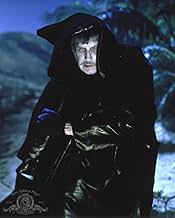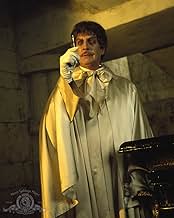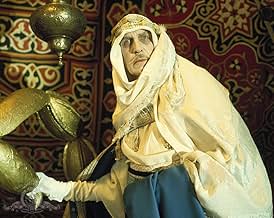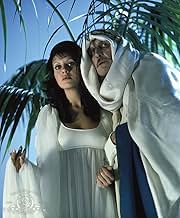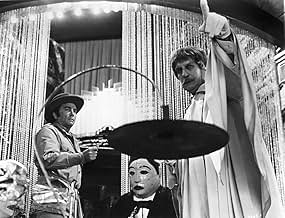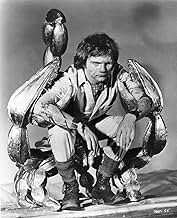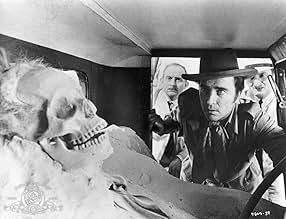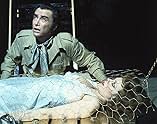IMDb RATING
6.3/10
7.5K
YOUR RATING
The vengeful doctor rises again, seeking the Scrolls of Life in an attempt to resurrect his deceased wife.The vengeful doctor rises again, seeking the Scrolls of Life in an attempt to resurrect his deceased wife.The vengeful doctor rises again, seeking the Scrolls of Life in an attempt to resurrect his deceased wife.
- Awards
- 1 win & 2 nominations total
John Comer
- Ship's Officer
- (uncredited)
Caroline Munro
- Victoria Regina Phibes
- (uncredited)
Gary Owens
- Narrator
- (voice)
- (uncredited)
Storyline
Did you know
- TriviaThere was a lot of hostility between Vincent Price and Robert Quarry, particularly when Price discovered that American International Pictures was planning to replace him with Quarry as their major horror film star. At one point, when Price discovered Quarry singing opera, Quarry said "I'll bet you didn't know I could sing, did you?", to which Price replied "Well, I knew you weren't a fucking actor."
- GoofsAt the end of the film, which takes place in 1928, Phibes sings "Somewhere Over The Rainbow", a song that was first recorded in 1938, 10 years later.
- Quotes
Inspector Trout: I'm a bit apprehensive about finding the others, sir. Do you think you know where we are?
Sir Wayne Waverley: Trout, I don't think; I know.
Inspector Trout: I don't think you know either, sir.
- Crazy creditsThis time, Phibes laughs just before the last chord of the music after the credits.
- Alternate versionsIn later prints of the film and in the original home video version of it, a scene featuring Vincent Price singing "Somewhere Over the Rainbow" is removed, supposedly for copyright reasons. The film's 2001 DVD version restores the Vincent Price-sung song "Somewhere Over the Rainbow".
- ConnectionsEdited from The Abominable Dr. Phibes (1971)
- SoundtracksOver the Rainbow
(uncredited)
Music by Harold Arlen
Performed by Vincent Price
(played over the end titles)
Featured review
This movie is so similar to the original that I sometimes have trouble remembering which crazy diabolical way of murdering his enemies occurred in which movie. Dr. Phibes returns (even though we DISTINCTLY saw him kill himself in the last movie!) and this time he is a little less focused on revenge and devotes most of his energy to resurrecting his long dead wife. However, have no fear, this does NOT mean he won't be killing many people in the process of restoring her! Yep, once again he comes up with many wacky and twisted ways to kill. So, in essence, if you loved the first movie you'll be happy but if you hated it, it doesn't get any better! I liked both and admit they are a guilty pleasure---they are SO cheesy and silly but I really liked the movies a lot!
UPDATE: I just saw this movie again tonight just after seeing the first Phibes film. I sure had a different reaction this time. While Phibes' murders were once again quite interesting, the film had two major ways that made it very inferior to the original. In the first film, whether right or wrong, Phibes felt he had a legitimate reason to kill. Here in "Dr. Phibes Rises Again" he clearly kills completely innocent people and is much more of a jerk. Also, the plot is not nearly as coherent as the first film and seems like it could have used some re-writing. Still worth seeing but clearly not up to the standards of the first.
UPDATE: I just saw this movie again tonight just after seeing the first Phibes film. I sure had a different reaction this time. While Phibes' murders were once again quite interesting, the film had two major ways that made it very inferior to the original. In the first film, whether right or wrong, Phibes felt he had a legitimate reason to kill. Here in "Dr. Phibes Rises Again" he clearly kills completely innocent people and is much more of a jerk. Also, the plot is not nearly as coherent as the first film and seems like it could have used some re-writing. Still worth seeing but clearly not up to the standards of the first.
- planktonrules
- Jul 5, 2005
- Permalink
- How long is Dr. Phibes Rises Again?Powered by Alexa
Details
- Release date
- Country of origin
- Language
- Also known as
- El regreso del abominable Dr. Phibes
- Filming locations
- Production company
- See more company credits at IMDbPro
Contribute to this page
Suggest an edit or add missing content

Top Gap
By what name was Dr. Phibes Rises Again (1972) officially released in India in English?
Answer


